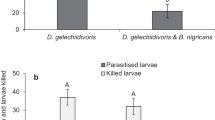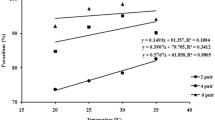Abstract
We evaluated the potential of two parasitoids as biocontrol agents of Liriomyza sativae Blanchard in northeastern Brazil. The two species were the koinobiont larval-pupal endoparasitoid Phaedrotoma scabriventris Nixon (Braconidae) and the idiobiont larval endoparasitoid Chrysocharis vonones (Walker) (Eulophidae). The biological parameters evaluated were survivorship, parasitism, and host-feeding, at 25 and 30°C. Differences between the species were observed at 25°C, but not at 30°C. At 25°C, the total parasitism for P. scabriventris (196.1 ± 17.7) and C. vonones (176.6 ± 7.24) was similar and with higher values compared to 30°C, 102.5 ± 8.81 and 89.1 ± 5 66 parasitized larvae, respectively. However, C. vonones showed a 3.97 lower survivorship as well as higher daily parasitism (1.4-fold) and host-feeding means (1.9-fold) than the braconid at 25°C. The results indicate a potential for both natural enemies to be used as biocontrol agents of L. sativae. The differences between species detected at 25°C suggest the best conditions for the application of each parasitoid.



Similar content being viewed by others
References
Abe Y (2017) Invasion of Japan by exotic leafminers Liriomyza spp. (Diptera: Agromyzidae) and its consequences. Appl Entomol Zool 52:175–182. https://doi.org/10.1007/s13355-017-0486-z
Achterberg V, Salvo A (1997) Reared Opiinae (Hymenoptera: Braconidae) from Argentina. Zool Meded 71:189–214
Akutse KS, Fiaboe KKM, Berg JV, Ekesi S, Maniania NK (2014) Effects of endophyte colonization of Vicia faba (Fabaceae) plants on the life-history of leafminer parasitoids Phaedrotoma scabriventris (Hymenoptera: Braconidae) and Diglyphus isaea (Hymenoptera: Eulophidae). PLoS One 9(1):–11. https://doi.org/10.1371/journal.pone.0109965
Allen WW, Charlton CA (1981) The biology of Diglyphus begini and its performance in caged releases on chrysanthemums. In: Schuster DJ (ed) Proceedings of the institute of food and agriculture sciences - industry conference on biological control of Liriomyza leafminers. University of Florida, Gainesville, pp 75–81
Amorim AP, Carmo Filho F, Espinola Sobrinho J. Dados meteorologicos de Mossoró (janeiro 1898 a dezembro de 1982). Mossoró: ESAM, 1983. 72 p
Araujo EL, Nogueira CHF, Bezerra CES, Costa EM (2015) Toxicidade de inseticidas utilizados na cultura do meloeiro para Opius scabriventris (Hymenoptera: Braconidae). Biosci J 31:1370–1377. https://doi.org/10.14393/BJ-v31n5a2015-26408
Carvalho AR, Bueno VHP, Silva DB, Costa VA (2011) Record of Diglyphus walker (Hymenoptera: Eulophidae) species in Brazil. Neotrop Entomol 40:290–291. https://doi.org/10.1590/S1519-566X2011000200023
Chabi-Olaye A, Mwikya NM, Fiaboe KKM (2013) Acceptability and suitability of three Liriomyza species as host for the endoparasitoid Phaedrotoma scabriventris: Implication for biological control of leafminers in the vegetable production system of Kenya. Biol Control 65:1–5. https://doi.org/10.1016/j.biocontrol.2013.01.007
Chien CC, Ku SC (2001) Instar preference of five species of parasitoids of Liriomyza trifolii (Hymenoptera: Eulophidae, Braconidae). Formos Entomol 21:89–97
Chow A, Heinz KM (2004) Biological control of leafminers on ornamental crops. In: Heinz KM, van Driesche RG, Parrella MP (eds). Biocontrol in Protected Culture. B Ball Publishing, Batavia, p. 221–38
Cisnero F, Mujica N (1999) The leafminer fly in potato: plant reaction and natural enemies as natural mortality factors. In: CIP (ed) Impact on a changing world: program report 1997-98. Lima, pp 130–140
Connor EF, Taverner MP (1997) The evolution and adaptative significance of leaf-mining habit. Oikos 79:6–25. https://doi.org/10.2307/3546085
Costa-Lima TC, Geremias LD, Parra JRP (2009) Efeito da temperatura e umidade relativa do ar no desenvolvimento de Liriomyza sativae Blanchard (Diptera: Agromyzidae) em Vigna unguiculata. Neotrop Entomol 38:727–733. https://doi.org/10.1590/S1519-566X2009000600004
Costa-Lima TC, Chagas MCM, Parra JRP (2014) Temperature-dependent development of two neotropical parasitoids of Liriomyza sativae (Diptera: Agromyzidae). J Insect Sci 14:1–4. https://doi.org/10.1093/jisesa/ieu107
Costa-Lima TC, Geremias LD, Parra JRP (2010) Reproductive activity and survivorship of Liriomyza sativae (Diptera: Agromyzidae) at different temperatures and relative humidity levels. Environ Entomol 39:195–201. https://doi.org/10.1603/En09209
Costa-Lima TC, Begiato AM, Geremias LD, Chagas MCM, Parra JRP (2017) Sistema de criação de parasitoide de mosca-minadora. Embrapa Semiárido, Petrolina, pp 1–8
Cure JR, Cantor F (2003) Predacious and parasitic activity of Diglyphus begini (Ashm.) (Hymenoptera: Eulophidae) on Liriomyza huidobrensis (Blanch.) (Diptera: Agromyzidae), in Gypsophila paniculata L. (Monocotiledonea: Caryophyllaceae) plants. Neotrop Entomol 32:85–89. https://doi.org/10.1590/S1519-566X2003000100012
Da Silva PM, Gauche C, Gonzaga LV, Costa ACO, Fett R (2016) Honey: chemical composition, stability and authenticity. Food Chem 196:309–323. https://doi.org/10.1016/j.foodchem.2015.09.051
Devkota S, Seal DR, Liburd OE, Ferguson S, Waddill CT, Martin CG (2016) Responses of Liriomyza trifolii (Diptera: Agromyzidae) to chemical and biorational insecticides. Fla Entomol 99:616–623. https://doi.org/10.1653/024.099.0405
Ferguson JS (2004) Development and stability of insecticide resistance in the leafminer Liriomyza trifolii (Diptera: Agromyzidae) to cyromazine, abamectin, and spinosad. J Econ Entomol 97:112–119. https://doi.org/10.1603/0022-0493-97.1.112
Foba CN, Salifu D, Lagat ZO, Gitonga LM, Akutse KS, Fiaboe KKM (2015) Liriomyza leafminer (Diptera: Agromyzidae) parasitoid complex in different agroecological zones, seasons, and host plants in Kenya. Environ Entomol 45(2):357–366. https://doi.org/10.1093/ee/nvv218
Guantai MM, Ogol CPKO, Salifu D, Kasina JM, Akutse KS, Fiaboe KKM (2015) Differential effects of pesticide applications on Liriomyza huidobrensis (Diptera: Agromyzidae) and its parasitoids on pea in Central Kenya. J Econ Entomol 108:662–671. https://doi.org/10.1093/jee/tov006
Guimarães JA, Braga Sobrinho R, Azevedo FR, Araujo EL, Terão D, Mesquita ALM (2008) Manejo integrado de pragas do meloeiro. In: Braga Sobrinho R, Guimarães JA, Freitas JAD, Terão D. (Eds.) Produção Integrada de Melão. Embrapa Agroindustria Tropical, Fortaleza, p. 183–199
Hernández R, Harris M, Liu T-X (2011) Impact of insecticides on parasitoids of the leafminer, Liriomyza trifolii, in pepper in south Texas. J Insect Sci 11:1–14. https://doi.org/10.1673/031.011.6101
Hondo T, Koike A, Sugimoto T (2006) Comparison of thermal tolerance of seven native species of parasitoids (Hymenoptera: Eulophidae) as biological control agents against Liriomyza trifolii (Diptera: Agromyzidae) in Japan. Appl Entomol Zool 41:73–82. https://doi.org/10.1303/aez.2006.73
Jervis MA, Ellers J, Harvey JA (2008) Resource acquisition, allocation, and utilization in parasitoid reproductive strategies. Annu Rev Entomol 53:361–385. https://doi.org/10.1146/annurev.ento.53.103106.093433
Jervis MA, Hawkins B, Kidd N (1996) The usefulness of destructive host feeding parasitoids in classical biological control: theory and observation conflict. Ecol Entomol 21:41–46. https://doi.org/10.1111/j.1365-2311.1996.tb00264.x
Kidd NAC, Jervis MA (1989) The effects of host-feeding behaviour on the dynamics of parasitoid-host interactions, and the implications for biological control. Res Popul Ecol (Kyoto) 31:235–274. https://doi.org/10.1007/BF02513204
Klapwijk J, Martinez ES, Hoogerbrugge H, Boogert M, Den Bolckmans K (2005) The potential of the parasitoid Chrysonotomyia formosa for controlling the tomato leafminer Liriomyza bryoniae in Dutch tomato greenhouses in winter. IOBC/wprs Bulletin 28:155–158
Liu T, Kang L, Heinz KM, Trumble J (2009) Biological control of Liriomyza leafminers : progress and perspective. CAB Rev Perspect Agric Vet Sci Nutr Nat Resour 4:1–16. https://doi.org/10.1079/PAVSNNR20094004
Liu TX, Kang L, Lei Z, Hernandez R (2010) Hymenopteran parasitoids and their role in biological control of vegetable Liriomyza leafminers. In: Liu TX, Kang L (eds) Recent advances in entomological research: from molecular biology to pest management. Higher Education Press, Beijing, pp 228–243
Matsuda K, Saito T (2014) Insecticide susceptibility and carboxylesterase activity in leafminers (Diptera: Agromyzidae) and their associated hymenopteran parasitoids. Crop Prot 55:50–54. https://doi.org/10.1016/j.cropro.2013.10.011
Minkenberg OPJM (1989) Temperature effects on the life history of the eulophid wasp Diglyphus isaea, an ectoparasitoid of leafminers (Liriomyza spp.), on tomatoes. Ann Appl Biol 115:381–397. https://doi.org/10.1111/j.1744-7348.1989.tb06558.x
Minkenberg OPJM, van Lenteren JC (1986) The leafminers Liriomyza bryoniae and L. trifolii (Diptera: Agromyzidae), their parasites and host plants: a review. Agric Univ Wageningen Pap 1–50.
Murphy ST, Lasalle J (1999) Balancing biological control strategies in the IPM of New World invasive Liriomyza leafminers in field vegetable crops. BiocontrolNews Inf 20:91–104
Nixon G (1955) Los Insectos de las Islas Juan Fernández. Rev Chil Entomol 4:159–165
Noyes JS (2017) Universal Chalcidoidea Database. http://www.nhm.ac.uk/chalcidoids. Accessed 10 Oct 2017
Parra J (2014) Biological control in Brazil: an overview. Sci Agric 71:345–355. https://doi.org/10.1590/0103-9016-2014-0167
Petitt FL (1990) Distinguishing larval instars of the vegetable leafminer, Liriomyza sativae (Diptera: Agromyzidae). Fla Entomol 73:280–286. https://doi.org/10.2307/3494812
Plouvier NW, Wajnberg E (2018) Improving the efficiency of augmentative biological control with arthropod natural enemies: a modeling approach. Biol Control 125:121–130. https://doi.org/10.1016/j.biocontrol.2018.05.010
R Development Core Team (2017) R: A language and environment for statistical computing. R Foundation for Statistical Computing, Vienna. https://www.R-project.org/. Accessed 09 Jan 2019
Salvo A, Valladares G (1998) Taxonomic composition of hymenopteran parasitoid assemblages from agromyzid leaf-miners sampled in Central Argentina. Stud Neotropical Fauna Environ 33:116–123. https://doi.org/10.1076/snfe.33.2.116.2157
Salvo A, Valladares GR (1997) An analysis of leaf-miner and plant host ranges of three Chrysocharis species (Hym.: Eulophidae) from Argentina. Entomophaga 42:417–426. https://doi.org/10.1007/BF02769835
Simberloff D (2012) Risks of biological control for conservation purposes. BioControl 57:263–276. https://doi.org/10.1007/s10526-011-9392-4
Tran DH, Ueno T, Takagi M (2007) Comparison of the suitability of Liriomyza chinensis and L. trifolii (Diptera: Agromyzidae) as hosts for Neochrysocharis okazakii (Hymenoptera: Eulophidae). Biol Control 41:354–360. https://doi.org/10.1016/j.biocontrol.2007.02.007
van der Linden A (2004) Biological control of leafminers on vegetable crops . In: Heinz KM, van Driesche RG, Parrella MP (eds) Biocontrol in Protected Culture. B Ball Publishing, Batavia, p. 235–51
van Lenteren JC (2012) The state of commercial augmentative biological control: plenty of natural enemies, but a frustrating lack of uptake. BioControl 57:1–20. https://doi.org/10.1007/s10526-011-9395-1
Waage JK, Carl KP, Mills NJ, Greathead DJ (1985) Rearing entomophagous insects. In: Singh P, Moore RF (eds) Handbook of insect rearing. Elsevier, New York, pp 45–66
Wei QB, Lei ZR, Nauen R, Cai DC, Gao YL (2015) Abamectin resistance in strains of vegetable leafminer, Liriomyza sativae (Diptera: Agromyzidae) is linked to elevated glutathione S-transferase activity. Insect Sci 22:243–250. https://doi.org/10.1111/1744-7917.12080
Wickham H (2009) ggplot2: elegant graphics for data analysis. Springer, New York, p 213
Acknowledgements
We thank Dr. V. Costa (Instituto Biológico, Brazil) and Dr. M. Fischer (Naturhistorisches Museum, Austria) for the identification of the parasitoids and the Coordenação de Aperfeiçoamento de Nível Superior (CAPES) for a grant to the first author.
Funding
This study was financially supported by the National Institute of Science and Technology of Semiochemicals in Agriculture (CNPq/FAPESP).
Author information
Authors and Affiliations
Contributions
TCCL, MCMC, and JRPP planned and designed the study, TCCL executed experimental work and conducted the data analyses, and TCCL, MCMC, and JRPP wrote the manuscript.
Corresponding author
Additional information
Edited by Madelaine Venzon – EPAMIG
Publisher’s Note
Springer Nature remains neutral with regard to jurisdictional claims in published maps and institutional affiliations.
Rights and permissions
About this article
Cite this article
Costa-Lima, T.C., Chagas, M.C.M. & Parra, J.R.P. Comparing Potential as Biocontrol Agents of Two Neotropical Parasitoids of Liriomyza sativae. Neotrop Entomol 48, 660–667 (2019). https://doi.org/10.1007/s13744-018-00667-0
Received:
Accepted:
Published:
Issue Date:
DOI: https://doi.org/10.1007/s13744-018-00667-0




